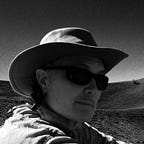Per Ardua Ad Astra
My grandfather — C.W. Snook, above — flew with the Royal Flying Corps (RFC) in the First World War, and with the Royal Air Force (RAF) in the Second World War. Many years ago (long before he died at the age of ninety-eight) he bequeathed me his WWI photo album, which — as a kid obsessed with flying, and brought up on first-hand tales of WWI and WWII flyers — I treasured. Most of the photos were from his own camera (including the images here), and include photos of all the planes he pranged during training (“F.T.S Waddington — All Mine!”, below, plus, of course, the DH.4 above), some of the planes he successfully flew (including a Fokker Triplane after the end of the war), mess huts and officers, France and Germany from the air, etc.
I’m slowly trying to get the photos properly presented on my own web site (it’s going to take a long time), but in the meantime, here’s a slightly-edited version of the biographical note he wrote in 1983. It gives you some idea of the life he lived back then….
Royal Flying Corps 1917–1919 (RFC)
I joined up direct from Rossall School in early 1917 at the age of 18. I had no thought of any other arm of the Services — being taught to fly and having one’s own aeroplane seemed to me to be the ideal method of being considered patriotic!
I was not disappointed; the joy of throwing these small aeroplanes about the sky, amidst the lovely cumulus clouds really thrilled me. I got my wings and was posted to a Bomber Squadron in France in March 1918.
The aeroplanes were de Havilland 2-seaters — the pilot in front with a machine gun firing through the propeller; the gun was fixed so I had to aim the aircraft. The observer in the back seat had a free gun with which he fought off the Hun fighters who came too close! The enemy fighters always attacked from the rear.
We were a bomber and photographic reconnaissance Squadron (1 x one cwt bomb and 8 at 25 lbs!). We bombed at about 10,000 ft in a formation of about 10 aircraft, we were not usually badly attacked by Hun fighters, only the stragglers were picked off. Anti aircraft fire from the ground could also be quite accurate but did not usually do more than bore a few holes in the wings.
Photo patrols were a very different matter — we were alone at probably 20,000 ft in an open cockpit and it was extremely cold. Also we had no oxygen so were somewhat stupid, but the Hun was equally dull, so it did not matter very much; he did come up to attack at this height.
On many occasions I was alone (with observer in the back of course) and was attacked by up to 10 or more fighters. On three such shows I was badly shot up (the aeroplane, not me) and on one my observer was badly wounded and so was not able to return the enemy fire with his gun. The instrument panel in front of me had a bullet in six of the seven instruments, every shot had gone past my head!
On another occasion, both petrol tanks were pierced by enemy bullets. I therefore had no engine. I was many miles over the enemy country but I just managed to get to our own side and crashed into a huge shell hole.
After November 11th 1918 (Armistice Day) the squadron flew up to Cologne as part of the army of occupation. We formed an air mail service from Cologne to Masionelle (?) in N. France, another squadron then took the mail bags to Folkestone. We were therefore more or less the originators of the regular air mail. It was a very dicey do as the back seat was taken up with mail bags and so we were really alone with no observer in the back to do the navigation. Also the aeroplanes were not very suitable for low flying. This we had to do when the clouds were low, and we were flying in snowstorms (Jan, Feb, March in N. Europe) or some equally unsuitable weather. We had several pilots who had bad crashes on trying to land after being lost.
I was on this job from Jan 1919 until I was demobbed in May.
Per Ardua Ad Astra
I did 6 years in the R.A.F. in the second war and did quite a lot of flying but not on operations. I became Chief Ground Instructor (C.G.I.) at operational training units with the rank of Squadron Leader.
For this work I was “Mentioned in a Despatch for distinguished service”.
C.W. Snook, 1983.
